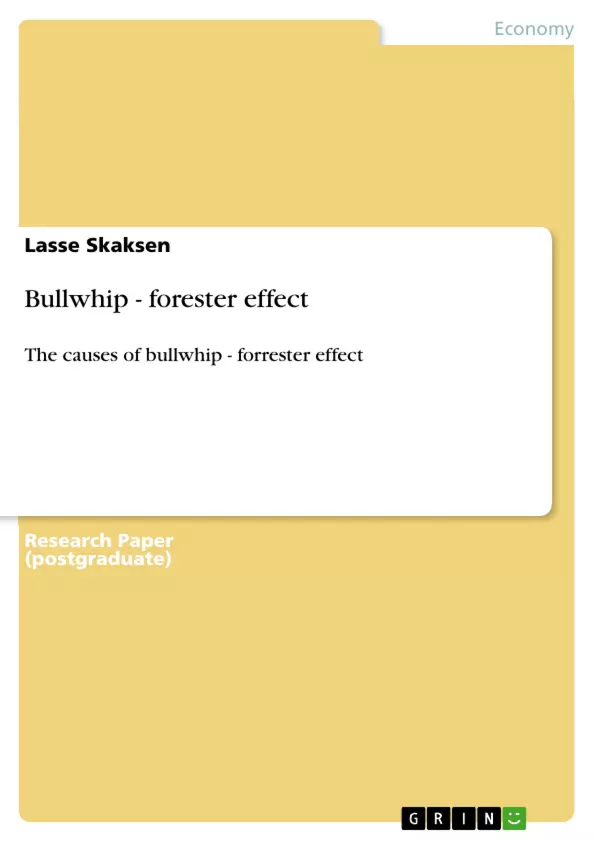The phenomenon where orders to the supplier tend to have larger variance than sales to the buyer (i.e. demand distortion), and the distortion propagates upstream in an amplified form (i.e. variance amplification)” is a simple yet precise definition of the bullwhip effect. With this definition as a reference point I will in this assignment investigate the bullwhip effect.
Supply network costs account for a significant proportion of a company’s costs. On average supply network costs in a pharmaceutical company is 9% of total costs and in supply companies on average 15%. We see significant differences, up to 12%, between “best in class” companies and the average company.
Table of Contents
- 1.0 Introduction
- 2.0 Implications of the Bullwhip effect
- 3.0 Two causes of the Bullwhip Effect
- 3.1 The rationing game
- 3.2 Order batching
- 5.0 Conclusion
Objectives and Key Themes
This assignment aims to identify, describe, define, and analyze the bullwhip effect, a common challenge in supply networks. It focuses on two key causes and their implications, without delving into solutions (which will be covered in a subsequent assignment).
- The definition and impact of the bullwhip effect on supply network costs and profitability.
- Analysis of the "rationing game" as a cause of the bullwhip effect.
- Examination of "order batching" as a contributing factor to the bullwhip effect.
- The implications of increased variance and volatility in supply networks.
- Real-world examples illustrating the bullwhip effect.
Chapter Summaries
1.0 Introduction: This introductory chapter defines the bullwhip effect as a phenomenon where order variance to suppliers exceeds sales variance to buyers, with this distortion amplifying upstream. It highlights the significant impact of supply network costs on overall company profitability, emphasizing the importance of effective supply network management, including mitigating the bullwhip effect. The chapter introduces the potential for substantial cost reductions and profitability increases through effective bullwhip management, setting the stage for a deeper analysis of its causes and implications.
2.0 Implications of the Bullwhip effect: This chapter explores the negative consequences of the bullwhip effect. Increased variance and volatility lead to higher inventory levels (and associated costs), reduced customer service and satisfaction due to longer lead times and stockouts, and inefficient resource allocation across manpower, production planning, and transportation. These factors cumulatively result in decreased profitability, underscoring the severity of the bullwhip effect and its wide-ranging impact on business operations.
3.0 Two causes of the Bullwhip Effect: This chapter focuses on two primary causes of the bullwhip effect: the rationing game and order batching. It analyzes the rationing game, drawing parallels to Nash Equilibrium, demonstrating how buyer suspicions of supply shortages incentivize inflated orders, leading to amplified demand variability. The chapter further explores order batching, explaining how periodic review processes and transaction costs contribute to the bullwhip effect. Both sections use illustrative examples to clarify the concepts and their impact on supply chain dynamics.
Keywords
Bullwhip effect, supply network management, demand variance, inventory costs, rationing game, order batching, volatility, profitability, supply chain efficiency, Nash Equilibrium, forecasting.
Frequently Asked Questions: A Comprehensive Language Preview
What is the main topic of this document?
This document provides a comprehensive preview of a language assignment focusing on the bullwhip effect in supply networks. It covers the definition, causes, implications, and key themes related to this phenomenon.
What are the key themes explored in this document?
The key themes include the definition and impact of the bullwhip effect on supply network costs and profitability; analysis of the "rationing game" and "order batching" as causes; implications of increased variance and volatility; and real-world examples illustrating the bullwhip effect. The document specifically avoids solutions, focusing instead on the problem's causes and consequences.
What is the bullwhip effect?
The bullwhip effect is a phenomenon where order variance to suppliers exceeds sales variance to buyers, amplifying demand variability upstream in the supply chain. This distortion leads to significant inefficiencies and costs.
What are the implications of the bullwhip effect?
The bullwhip effect leads to higher inventory levels and costs, reduced customer service due to stockouts and longer lead times, and inefficient resource allocation across manpower, production, and transportation. Ultimately, this results in decreased profitability.
What are the two main causes of the bullwhip effect discussed in this document?
The document focuses on two primary causes: The "rationing game," where buyer suspicions of supply shortages lead to inflated orders; and order batching, where periodic review processes and transaction costs contribute to demand variability.
How does the "rationing game" contribute to the bullwhip effect?
The "rationing game" illustrates how buyer behavior, driven by a fear of shortages, leads to inflated orders. This amplifies demand variability upstream, exacerbating the bullwhip effect. The concept draws parallels to Nash Equilibrium in game theory.
How does order batching contribute to the bullwhip effect?
Order batching, stemming from periodic review processes and transaction costs, contributes to the bullwhip effect by creating artificial demand fluctuations. The tendency to order in larger, less frequent batches masks underlying demand patterns and amplifies variations.
What is the structure of the document?
The document is structured with an introduction, a section outlining objectives and key themes, chapter summaries detailing the core concepts of each chapter, and a list of keywords. The chapters cover an introduction to the bullwhip effect, its implications, its causes (focusing on the rationing game and order batching), and a conclusion.
What is the overall goal of this document?
The document aims to provide a thorough understanding of the bullwhip effect, its causes, and its implications within supply networks. It sets the stage for a subsequent assignment that will delve into solutions to mitigate this effect.
What are the key words associated with this document?
Key words include: Bullwhip effect, supply network management, demand variance, inventory costs, rationing game, order batching, volatility, profitability, supply chain efficiency, Nash Equilibrium, and forecasting.
- Citar trabajo
- Lasse Skaksen (Autor), 2011, Bullwhip - forester effect, Múnich, GRIN Verlag, https://www.grin.com/document/233409



